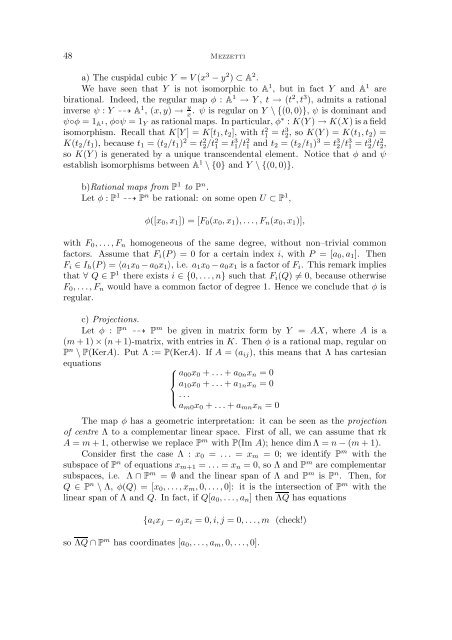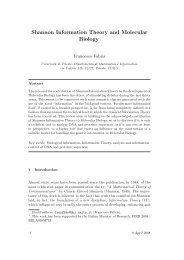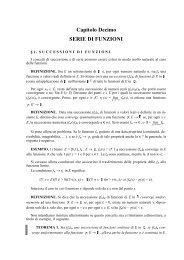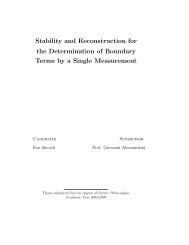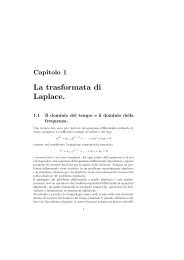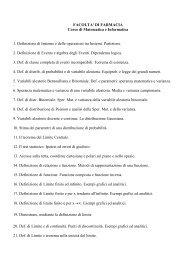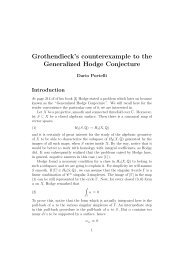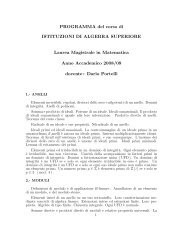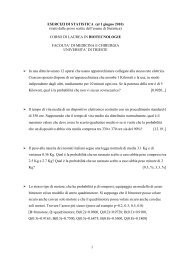INTRODUCTION TO ALGEBRAIC GEOMETRY Note del corso di ...
INTRODUCTION TO ALGEBRAIC GEOMETRY Note del corso di ...
INTRODUCTION TO ALGEBRAIC GEOMETRY Note del corso di ...
You also want an ePaper? Increase the reach of your titles
YUMPU automatically turns print PDFs into web optimized ePapers that Google loves.
48 Mezzettia) The cuspidal cubic Y = V (x 3 − y 2 ) ⊂ A 2 .We have seen that Y is not isomorphic to A 1 , but in fact Y and A 1 arebirational. Indeed, the regular map φ : A 1 → Y , t → (t 2 , t 3 ), admits a rationalinverse ψ : Y A 1 , (x, y) → y x. ψ is regular on Y \ {(0, 0)}, ψ is dominant andψ◦φ = 1 A 1, φ◦ψ = 1 Y as rational maps. In particular, φ ∗ : K(Y ) → K(X) is a fiel<strong>di</strong>somorphism. Recall that K[Y ] = K[t 1 , t 2 ], with t 2 1 = t3 2 , so K(Y ) = K(t 1, t 2 ) =K(t 2 /t 1 ), because t 1 = (t 2 /t 1 ) 2 = t 2 2 /t2 1 = t3 1 /t2 1 and t 2 = (t 2 /t 1 ) 3 = t 3 2 /t3 1 = t3 2 /t2 2 ,so K(Y ) is generated by a unique transcendental element. Notice that φ and ψestablish isomorphisms between A 1 \ {0} and Y \ {(0, 0)}.b)Rational maps from P 1 to P n .Let φ : P 1 P n be rational: on some open U ⊂ P 1 ,φ([x 0 , x 1 ]) = [F 0 (x 0 , x 1 ), . . ., F n (x 0 , x 1 )],with F 0 , . . ., F n homogeneous of the same degree, without non–trivial commonfactors. Assume that F i (P) = 0 for a certain index i, with P = [a 0 , a 1 ]. ThenF i ∈ I h (P) = 〈a 1 x 0 −a 0 x 1 〉, i.e. a 1 x 0 −a 0 x 1 is a factor of F i . This remark impliesthat ∀ Q ∈ P 1 there exists i ∈ {0, . . ., n} such that F i (Q) ≠ 0, because otherwiseF 0 , . . ., F n would have a common factor of degree 1. Hence we conclude that φ isregular.c) Projections.Let φ : P n P m be given in matrix form by Y = AX, where A is a(m + 1) × (n + 1)-matrix, with entries in K. Then φ is a rational map, regular onP n \ P(KerA). Put Λ := P(KerA). If A = (a ij ), this means that Λ has cartesianequations⎧a 00 x 0 + . . . + a 0n x n = 0⎪⎨a 10 x 0 + . . . + a 1n x n = 0⎪⎩ . . .a m0 x 0 + . . . + a mn x n = 0The map φ has a geometric interpretation: it can be seen as the projectionof centre Λ to a complementar linear space. First of all, we can assume that rkA = m + 1, otherwise we replace P m with P(Im A); hence <strong>di</strong>mΛ = n − (m + 1).Consider first the case Λ : x 0 = . . . = x m = 0; we identify P m with thesubspace of P n of equations x m+1 = . . . = x n = 0, so Λ and P m are complementarsubspaces, i.e. Λ ∩ P m = ∅ and the linear span of Λ and P m is P n . Then, forQ ∈ P n \ Λ, φ(Q) = [x 0 , . . ., x m , 0, . . ., 0]: it is the intersection of P m with thelinear span of Λ and Q. In fact, if Q[a 0 , . . ., a n ] then ΛQ has equations{a i x j − a j x i = 0, i, j = 0, . . ., m (check!)so ΛQ ∩ P m has coor<strong>di</strong>nates [a 0 , . . ., a m , 0, . . ., 0].


